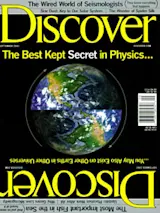The tabby crouched on the cage's platform is fiercely attentive, as if he's not sure whether he's the hunter or the hunted. Something's different about this cat: His big blue eyes are a little too close together, his nose a bit long, and his limbs on the rangy side— even for a tom. Among the dozens of friendly felines romping in a nearby corridor, this one stands out, as nervous and haughty as the last cat on Earth.
This canister, chilled to -372 degrees Fahrenheit, contains sperm and embryos, as well as samples of tissue and skin, of many different species.Photograph Courtesy of Audubon Nature Institute
Actually, Jazz is the first of his kind, an endangered African wildcat born almost two years ago from a frozen embryo that was implanted in an ordinary house cat. Acting as midwife was Betsy Dresser, director of the Audubon Center for Research of Endangered ...














